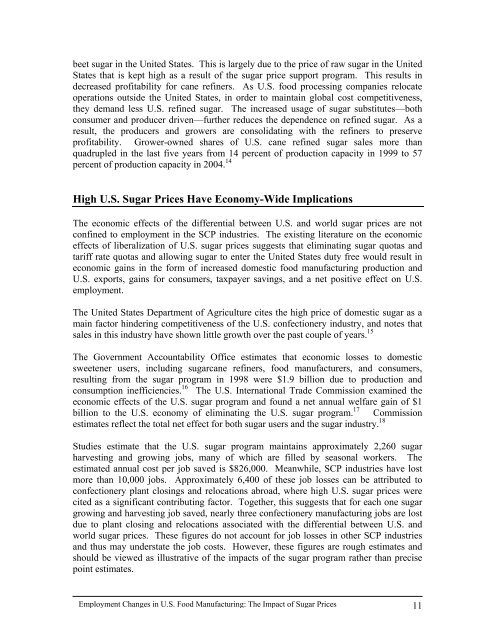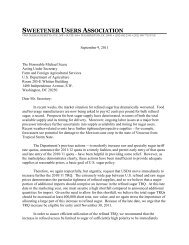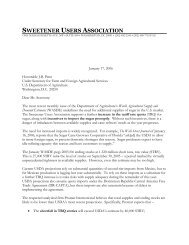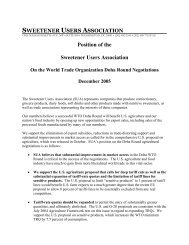Employment Changes in US Food Manufacturing - Coalition for ...
Employment Changes in US Food Manufacturing - Coalition for ...
Employment Changes in US Food Manufacturing - Coalition for ...
You also want an ePaper? Increase the reach of your titles
YUMPU automatically turns print PDFs into web optimized ePapers that Google loves.
eet sugar <strong>in</strong> the United States. This is largely due to the price of raw sugar <strong>in</strong> the United<br />
States that is kept high as a result of the sugar price support program. This results <strong>in</strong><br />
decreased profitability <strong>for</strong> cane ref<strong>in</strong>ers. As U.S. food process<strong>in</strong>g companies relocate<br />
operations outside the United States, <strong>in</strong> order to ma<strong>in</strong>ta<strong>in</strong> global cost competitiveness,<br />
they demand less U.S. ref<strong>in</strong>ed sugar. The <strong>in</strong>creased usage of sugar substitutes—both<br />
consumer and producer driven—further reduces the dependence on ref<strong>in</strong>ed sugar. As a<br />
result, the producers and growers are consolidat<strong>in</strong>g with the ref<strong>in</strong>ers to preserve<br />
profitability. Grower-owned shares of U.S. cane ref<strong>in</strong>ed sugar sales more than<br />
quadrupled <strong>in</strong> the last five years from 14 percent of production capacity <strong>in</strong> 1999 to 57<br />
percent of production capacity <strong>in</strong> 2004. 14<br />
High U.S. Sugar Prices Have Economy-Wide Implications<br />
The economic effects of the differential between U.S. and world sugar prices are not<br />
conf<strong>in</strong>ed to employment <strong>in</strong> the SCP <strong>in</strong>dustries. The exist<strong>in</strong>g literature on the economic<br />
effects of liberalization of U.S. sugar prices suggests that elim<strong>in</strong>at<strong>in</strong>g sugar quotas and<br />
tariff rate quotas and allow<strong>in</strong>g sugar to enter the United States duty free would result <strong>in</strong><br />
economic ga<strong>in</strong>s <strong>in</strong> the <strong>for</strong>m of <strong>in</strong>creased domestic food manufactur<strong>in</strong>g production and<br />
U.S. exports, ga<strong>in</strong>s <strong>for</strong> consumers, taxpayer sav<strong>in</strong>gs, and a net positive effect on U.S.<br />
employment.<br />
The United States Department of Agriculture cites the high price of domestic sugar as a<br />
ma<strong>in</strong> factor h<strong>in</strong>der<strong>in</strong>g competitiveness of the U.S. confectionery <strong>in</strong>dustry, and notes that<br />
sales <strong>in</strong> this <strong>in</strong>dustry have shown little growth over the past couple of years. 15<br />
The Government Accountability Office estimates that economic losses to domestic<br />
sweetener users, <strong>in</strong>clud<strong>in</strong>g sugarcane ref<strong>in</strong>ers, food manufacturers, and consumers,<br />
result<strong>in</strong>g from the sugar program <strong>in</strong> 1998 were $1.9 billion due to production and<br />
consumption <strong>in</strong>efficiencies. 16 The U.S. International Trade Commission exam<strong>in</strong>ed the<br />
economic effects of the U.S. sugar program and found a net annual welfare ga<strong>in</strong> of $1<br />
billion to the U.S. economy of elim<strong>in</strong>at<strong>in</strong>g the U.S. sugar program. 17 Commission<br />
estimates reflect the total net effect <strong>for</strong> both sugar users and the sugar <strong>in</strong>dustry. 18<br />
Studies estimate that the U.S. sugar program ma<strong>in</strong>ta<strong>in</strong>s approximately 2,260 sugar<br />
harvest<strong>in</strong>g and grow<strong>in</strong>g jobs, many of which are filled by seasonal workers. The<br />
estimated annual cost per job saved is $826,000. Meanwhile, SCP <strong>in</strong>dustries have lost<br />
more than 10,000 jobs. Approximately 6,400 of these job losses can be attributed to<br />
confectionery plant clos<strong>in</strong>gs and relocations abroad, where high U.S. sugar prices were<br />
cited as a significant contribut<strong>in</strong>g factor. Together, this suggests that <strong>for</strong> each one sugar<br />
grow<strong>in</strong>g and harvest<strong>in</strong>g job saved, nearly three confectionery manufactur<strong>in</strong>g jobs are lost<br />
due to plant clos<strong>in</strong>g and relocations associated with the differential between U.S. and<br />
world sugar prices. These figures do not account <strong>for</strong> job losses <strong>in</strong> other SCP <strong>in</strong>dustries<br />
and thus may understate the job costs. However, these figures are rough estimates and<br />
should be viewed as illustrative of the impacts of the sugar program rather than precise<br />
po<strong>in</strong>t estimates.<br />
<strong>Employment</strong> <strong>Changes</strong> <strong>in</strong> U.S. <strong>Food</strong> Manufactur<strong>in</strong>g: The Impact of Sugar Prices 11













